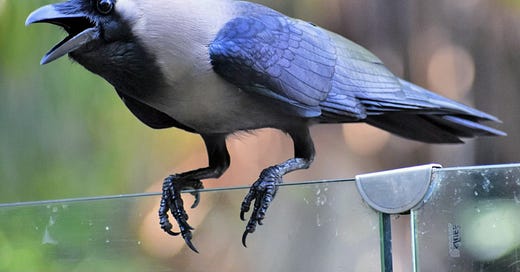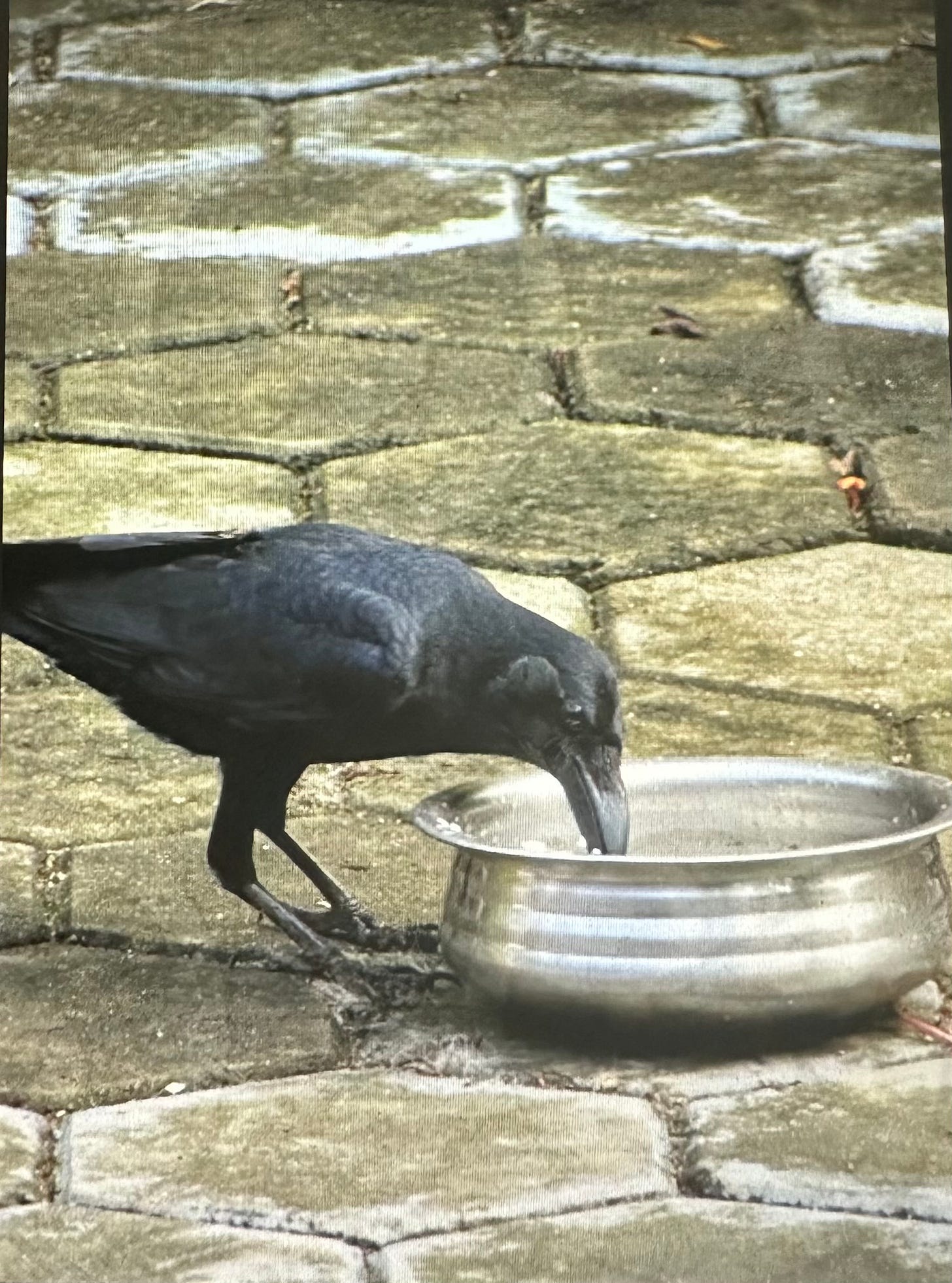Dear friends,
In two days, I’ll be setting foot on my birth land of Mumbai, India. I can already smell the damp earth of the monsoons and feel my heart flutter at the inevitable anticipation and excitement of touching motherland. However, prime on my mind this year, is the crow.
Kaaw…you heard that right.
Every year, the appeal of the crow is incessant—stubborn even—perched on the right panel of the aged wooden door that’s the entrance to my 600-foot childhood home in Mumbai. This genus Corvidae even elegantly bends and pokes the front of his long slender frame into the house, peering carefully at the tiny interiors with his beady eyes, “Kaaw, kaaw, kaaw…” “Hurry up! I am hungry!”
The house crow or Corvus splendens is of Asian origin. The forehead, crown, throat, and upper breast are a richly glossed black, while the neck and breast are a lighter gray-brown in color.
Amma (mom) looks at the black avian that visits her thrice (yes!) a day—at 8:30 am, mid-day at 12:30 pm, and at 4:30 pm—and says matter-of-factly to me,
“There, your Nanna (father) has arrived.”
My late dad is not a crow. The words invariably rouse my first bout of irritation, but not before drawing an indulgent chuckle at the slight absurdity of the situation I have been a witness to each year I visit home.
Corvus versus homo
Amma embraces the crow as my dad. I refuse to accept the black and gray plumed creature as a father figure.
The visuals do not even match, for heaven’s sake! My late father was a vision in white: he sported a mop of snowy white hair meticulously oiled and combed back, a thick brush of white mustache, and perpetually wore a white jubba and a dhoti to match.
Black and white…the late Michael Jackson’s lyrics come to mind:
I said if you're thinkin' of being my brother father
It don't matter if you're black or white
It does matter to me. Not the race. An entire genus, namely Corvus, the crow’s family, is being confused with homo, the genus of my dad and us readers.
In the meanwhile, our household help, Usha, yells lazily in Marathi at the avian visitor, Marathi being the local language of Mumbai, “Ho, thamba ki, me yété,” or “Yes, please wait, I am coming”. She rushes out with her bowl of cooked white rice, promptly placing it outside our apartment—located at the street level—in the common area of our building. In India, that’s called a compound—no, not a science experiment kind of a compound—but the common concrete enclosure surrounding an apartment building.
Soon, father crow and his fellow avians flutter around, noisily and greedily pecking on the plump grains, invariably creating a mess.
“That is not Nanna!” I say exasperatedly to my mother. Not that it matters, but I feel the need to protest in honor of my dad’s human memory and his un-Corvidae behaviors: he was well spoken, frank, and forthright, and he did not kaaw.
“What difference does it make to you? It may be your father, grandfather, your grandmother even,” says my mother, seated on her diwan or a small cot. Amma is always in direct view of our front compound, making sure the household help is doing what she is supposed to do. My 86-year-old mother sure runs a tight ship of a house, I must say.
Crow as a grandma figure?
Last year, my 13-year-old fondly declared, much to mom’s consternation, that his “chubby Ammama” or grandmother’s behavior was much like the visiting crow.
“What do you mean?!” exclaimed Amma.
He explained that she sits on her diwan most of the day, gently bobbing her head from left to right—just like a crow—making sure that the outside world is doing what it’s supposed to do.
I both suppressed a smile and glared angrily at my son to chastise.
In response, mom temporarily shooed him away to the neighboring sofa, saying he could no longer sit or fall all over her for the rest of the day. Of course, within a few minutes, my son flew back to his usual perch on the diwan, pecking at her with his usual mischief.
Crow as a public health menace—not a grain please!
It’s not uncommon in Sanatana Dharma or Hinduism to believe that crows are a link between the worlds of the living and the dead. Hindus in India even feed crows on the death anniversary of a deceased family member.
It’s just that in our household, an annual ritual has turned into daily practice, thrice a day that is. The afternoon visit from the corvid also doubles as an alarm, the kaaw, kaaw…waking up both mom and Usha from deep afternoon slumber. These days, I heard, father crow is fed ganthiya, a popular gram flour-based snack modified to suit the taste buds of crows. Crow food!
Ganthiya is a popular Indian snack made of chickpea flour and originates in the West Indian state of Gujarat. I absolutely love it and can binge till I get a tummy ache. Now the crows of Mumbai can too, with their own version, it seems.
Last year, I had it—the bone of contention for me was hygiene. The rice granules create a mess, not to mention, they are an ungainly sight in the common area of the building. They might attract rodents or other creatures. Usha promptly cleared away the rice bits by drenching the concrete with water and sweeping away all remnants into the drain located outside our apartment building.
She hoped I’d soften, with her diligent cleaning. But I was bent on stopping this routine—despite my mother’s argument that I was being heartless. I banned both mom and Usha from crow feeding of any kind for the duration of my stay and yonder, warning them that it must not ever happen, ever again. In the interest of personal hygiene and public health.
“There’s no point starving our ancestors,” said my mother.
“That is not Nanna, nor any of our ancestors!” I retorted.
“You were always very stubborn, Purni (my nickname). Even your 4th grade teacher, Mrs. Lobo, saw right through you. You have not changed one bit. Maturity has not yet come!”
And there’s that.
On crows and spirituality
Back in the US, this year, I decided to dig earnestly into the spiritual basis of this crow-as-a-father worship. I checked with some of my girlfriends at the spiritual center I attend every week Some acknowledged that crows are symbolic of the souls of the recently deceased or the ancestors. But there was no empathy at my indignation that Amma fed crows thrice a day, one of which she thinks is my late dad.
One friend exclaimed, “Let your mom get comfort from the fact that your dad visits her daily!”
“As a crow?!”
I asked my Vedanta guru as to how to handle this with less exasperation and he responded, “Life is divine in any form, Annapurna!”
True, I can accept divinity in a crow. In fact, crows are intelligent and useful creatures—they keep insects, even rodents and dead animals at bay. They are also creatures that have gained a reputation for wisdom and trickery in history and literature.
It’s just that I can’t accept the crow as my father.
Swamiji responded with patience:
“Life has no particular form!
Life embodies all forms!
Life is beyond all forms!”
He encouraged me to read a few verses from a book soon to be published called Puja Vidhanam. One of the verses alludes to the fact that continuously, at all times, an awareness must be cultivated that I am seeing nothing but Him, in another form.
Yes, I know, the conversation has just turned spiritual. But that’s OK. I don’t separate the daily from the spiritual, anyway. And maybe, if there was a way to resolve this via spirituality, my mom, moi, and the crows of my home would be at peace.
Swamiji was asking me in essence to train myself to see the universal Brahman or the Divine in the crow. In Hinduism, the path to spiritual enlightenment often involves karma kanda or performing rituals and practices that can expand one's consciousness. I admit, I am not big into rituals, but from this point of view, participating in the ritual of thoughtfully feeding the crow—an unassuming and humble creature—and reflecting on the process, can enhance our spiritual awareness by connecting with the divine presence in him.
Yes, the unassuming crow can foster spiritual awareness.
I can accept that, but…without seeing my dad in the crow. However, I realized, my mother sees both the divine and my dad in the crow. Maybe through the eyes of my mother, I could try to see the divine and hence my father in the crow?
I could indulge her more and judge less, maybe?
Coming this year: goodbye birth home, goodbye crow
Maybe this is the year of acceptance and I’ll see the father-crow situation more compassionately instead of with exasperation.
Especially because my birth home of 100 years along with the 5 other apartments above it, will be demolished. They will be replaced with a sparkling new high rise—out with the old, in with the new.
With the building gone, I wonder if my crow-dad might take a flight of fancy elsewhere, plant himself into someone else’s imagination, like the Raven did with Edgar Allen Poe, sparking unforgettable poetry. Or, is it likely to return to my mom’s temporary new digs, literally in the neighboring apartment building? If it does, that’ll certainly lend credibility to the crow-dad story.
Whatever be the case, the father crow is captured here forever, in my words. Amma can treasure this story as a memory and I can treasure it as a lesson learned in acceptance and spirituality.
A kaaw for that thought…
Meaningfully yours,
Anu Prabhala
PS: I do not wish to offend anyone with this post. My goal is to see humor in my life with the perpetual conflict between customs and traditions on one hand, and modern living on the other.








Hi Anu.....just enjoyed reading the kaaw story....hahaha....keep up the good work. l like the way you create humour in a very simple story....
What a charming tale! I was smiling throughout those interactions. I cannot wait to read what happens during this trip.
It is sad that the city is losing yet another old building. And I hope the crows find their way to your Amma next door.